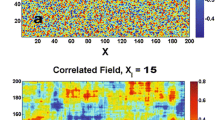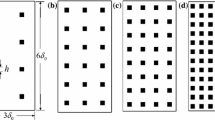Abstract
The distribution of rainfall over small-scale topography of uniformroughness was studied both numerically and from field observations. Field data haveshown that small-scale topographic inhomogeneities (hills and valleys of afew tens of metres in height) substantially influence the rainfalldistribution over the inhomogeneity itself and also some distance downwind from it.According to comprehensive rainfall measurements carried out in a smallwatershed, windward slopes received less conventionally-measured rain than lee-sides.Moreover, on the windward slope rainfall decreased uphill, to apronounced minimum near the crest. In addition, ‘directional’ raingages,situated at the bottom of both slopes revealed a pattern suggesting a reversedsurface flow on the lower slopes. This pattern persisted through a variety ofbackground conditions.
To explain the observed data, a numerical simulation of both the windfieldand of drop trajectories was carried out. The windfield was generated insimulations using the Colorado State University RAMS model with a very highresolution (5 m in the horizontal). Drop trajectories were calculated usingan equation for the motion of drops in a flow field that incorporates currentexperimental results.
A strong effect of small-scale topography on drop trajectories wasfound. The simulation results are encouraging and help to explain manycharacteristic features of precipitation distributions observed in fieldexperiments.
Similar content being viewed by others
References
Alpert, P. and Shafir, H.: 1989, 'Physical Model to Complement Rainfall Normals over a Complex Terrain', J. Hydrol. 110, 51–62.
Barrow, A. P. and Lettenmeier, D. P.: 1994, 'Dynamic Modelling of Orographically-Induced Precipitation', Rev. Geophys. 32, 265–284.
Basist, A., B ell, G.D., and Meentemeyer, V.: 1994, 'Statistical Relationships between Topography and Precipitation Patterns', J. Climate 7(9), 1305–1315.
Craig, D.: 1980, 'Two Examples of the Effect of Topography on Rainfall Distribution Patterns', Weather 35(10), 301–307.
Deardorff, J. W.: 1980, 'Stratocumulus-Capped Mixed Layer Driven from a Three-Dimensional Model', Boundary-Layer Meteorol. 18, 495–527.
Feingold, G. and Levin, Z.: 1986, 'The Log-Normal Fit to Raindrop Spectra from Frontal Convective Clouds in Israel', J. Climate Appl. Meteorol. 25, 1346–1363.
Finnigan, J.J.: 1988, 'Airflow over Complex Terrain', in: W. K. Steffen and O. T. Denmead (eds.), Flow and Transport in Natural Environments: Advances and Applications, Springer-Verlag, pp. 182–209.
Fourcade, H. G.: 1945, 'A Note onMultiple Rain-Gages',Transaction, American Geophysical Union 26, 267–268. (For a more detailed description see Fourcade, H. G.: 1942, 'Some Notes on the Effect of Incidence of Rain on the Distribution of Rainfall over the Surface of Unlevel Ground', Royal Soc. South Africa Transactions 29, 235-254.)
Gagin, A.: 1980, 'The Relationship between the Depth of Cumuliform Clouds and their Raindrops Characteristics', J. Recherches Atmos. 14, 409–422.
Gill, A. E.: 1982, Atmosphere-Ocean Dynamics, Academic Press, 662 pp.
Haiden, T., Kerschbaum, M., K ahlig, P., and Noblis, F.: 1992, 'A Refined Model of the Influence of Orography on the Mesoscale Distribution of Extreme Precipitation', Hydrology Sci. J. 37, 417–427.
Hovind, E. L.: 1965, 'Precipitation Distribution Around a Windy Mountain Peak', J. Geophys. Res. 70(14), 3271–3278.
Khain, A. P. and Pinsky, M. B.: 1995, 'Drops' Inertia and its Contribution to Turbulent Coalescence in Convective Clouds: Part 1: Drops' Fall in the Flow with Random Horizontal Velocity', J. Atmos. Sci. 52, 196–206.
Marchuk, G. I.: 1982, Methods of Numerical Mathematics, Springer-Verlag, New York, 510 pp.
Mason, P. J. and King, J. C.: 1984, 'Atmospheric Flow over a Succession of Nearly Two-Dimensional Ridges and Valleys', Quart. J. Roy. Meteorol. Soc. 110, 821–845.
Mink, J. F.: 1960, 'Distribution Patterns of Rainfall in the Leeward Koolau Mountains, Oahu, Hawaii', J. Geophys. Res. 65(9), 2869–2876.
Poreh, M. and Mechrez, E.: 1984, 'The Combined Effect of Wind and Topography on Rainfall Distribution', J. Hydrol. 72, 1–23.
Pruppacher,H.R. and Klett, J. D.: 1978,Microphysics ofClouds and Precipitation,Reidel, Dordrecht, 714 pp.
Sharon, D.: 1980, 'The Distribution ofHydrologically EffectiveRainfall Incident on Sloping Ground', J. Hydrol. 46, 165–188.
Sharon, D. and Arazi, A.: 1993, 'The Distribution of Wind-Driven Rainfall and the Reconstructed Local Flow Affecting it in the Experimental Watershed near Lehavim', Final scientific report on rainfall studies conducted in the context of BARD project No. IS-1486-88, 1989–1992. Hebrew University of Jerusalem.
Sharon, D. and Arazi, A.: 1997, 'The Distribution of Wind-Driven Rainfall in a Small Valley: An Empirical Basis for Wind Modeling', J. Hydrol. (in press).
Sharon, D., Arazi, A., Khain, A., Huss, A., and Mahrer, Y.: 1994, 'The Effect of Topography on the Local Distribution of Rainfall and First Attempts in its Numerical Modeling', Meeting of the Commission of Climatology/IGU on Contemporary Climatology, Bruno, 15–20, August, 1994.
Sharon, D., Morin, J., and Moshe, Y.: 1988, 'Micro-Topographical Variations of Rainfall Incident on Ridges of a Cultivated Field', Amer. Soc. Agric. Eng. 31(6), 1715–1722.
Stein, U. and Alpert, P.: 1993, 'Factor Separation in Numerical Simulations', J. Atmos. Sci. 50, 2107–2115.
Stout, J. E., Lin, Y.-L., and Arya, S. P. S.: 1993, 'A Theoretical Investigation of the Effects of Sinusoidal Topography on Particle Deposition', J. Atmos. Sci. 50, 2533–2541.
Taylor, P. A., Mason, P. J., and Bradley, E. F.: 1987, 'Boundary-Layer Flow over Low Hills', Boundary-Layer Meteorol. 39, 107–132.
Tripoli, G. J. and Cotton, W. R.: 1982, 'The Colorado State University Three Dimensional Cloud/Mesoscale Model', J. Recherches Atmos. 16, 185–219.
Wang, L-P. and Pruppacher, H. R.: 1977,' 'Acceleration to Terminal Velocity of Cloud and Rain Drops', J. Appl. Meteorol. 16, 275–280.
Weston, K. J. and Roy, M. G.: 1994, 'The Directional Dependence of the Enhancement of Rainfall over Complex Orography', Meteorol. Applications 1, 267–275.
Author information
Authors and Affiliations
Rights and permissions
About this article
Cite this article
ARAZI, A., SHARON, D., KHAIN, A. et al. THE WINDFIELD AND RAINFALL DISTRIBUTION INDUCED WITHIN A SMALL VALLEY: FIELD OBSERVATIONS AND 2-D NUMERICAL MODELLING. Boundary-Layer Meteorology 83, 349–374 (1997). https://doi.org/10.1023/A:1000243312103
Issue Date:
DOI: https://doi.org/10.1023/A:1000243312103




